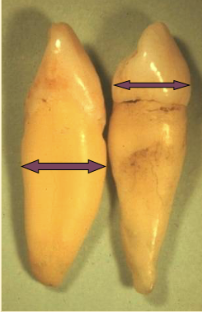permanent anterior maxillary and mandibular
1/70
There's no tags or description
Looks like no tags are added yet.
Name | Mastery | Learn | Test | Matching | Spaced |
|---|
No study sessions yet.
71 Terms
maxillary central incisors #8 and #9; formation begins
3-4 months
maxillary central incisors #8 and #9; eruption
7-8 years
maxillary central incisors #8 and #9; root completion
10 years

maxillary central incisors #8 and #9; CEJ
smooth convex curve toward the apex of the root
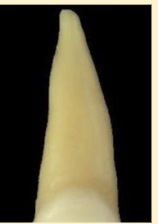
maxillary central incisors #8 and #9; root shape
smoothly tapered conical shape. thick in cervical third and narrows through the middle to a blunt apex
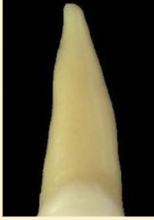
maxillary central incisors #8 and #9; root cross section
is triangular

maxillary central incisors #8 and #9; root apex
may curve toward distal or facial but typically not common
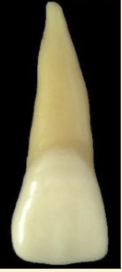
maxillary central incisors #8 and #9; distal edge
more rounded
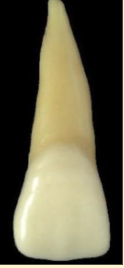
maxillary central incisors #8 and #9; mesial edge
approx. 90 degrees

maxillary central incisors #8 and #9; lingual fossa
surrounded by 4 convexities:
1. mesial MR-- longer
2. distal MR
3. cingulum-- distal
4. incisal Ridge/Edge

maxillary central incisors #8 and #9; cingulum
displaced toward the distal

maxillary central incisors #8 and #9; contacts
distal contact more cervical than mesial contact
maxillary central incisors #8 and #9; height of contour; facial
cervical 1/3
maxillary central incisors #8 and #9; height of contour; lingual
cingulum
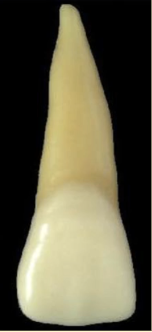
maxillary central incisors #8 and #9; crown to root ratio
1:1 ratio between the root and crown, almost the same size
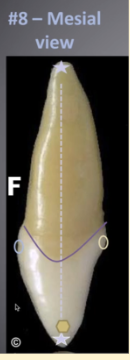
maxillary central incisors #8 and #9; apex and crown alignment
almost a straight line
maxillary central incisors #8 and #9; functoins
cut
articulate speech
support lip
maintain esthetic appearance
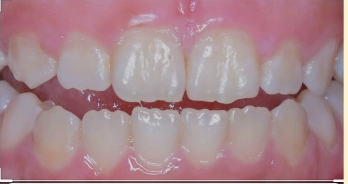
incisor mamelons
developmental protuberances of enamel on the incisal edges of newly erupted teeth. Lobes of development (4)
maxillary lateral incisors #7 and #10; formation begins:
10-12 months
maxillary lateral incisors #7 and #10; eruption:
8-9 years
maxillary lateral incisors #7 and #10; root completion:
11 years
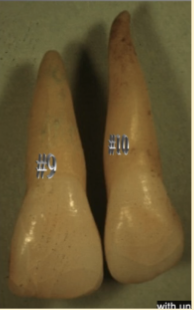
maxillary lateral incisors #7 and #10; root
*LONGER ROOT than maxillary centrals, curves toward distal
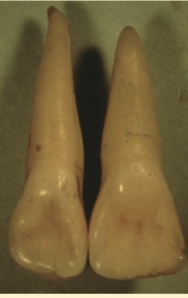
maxillary lateral incisors #7 and #10; lingual view
Deeper lingual fossa than maxillary centrals
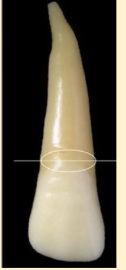
maxillary lateral incisors #7 and #10; cross section
ovoid
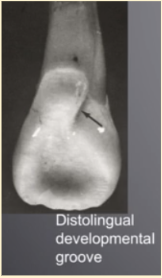
maxillary lateral incisors #7 and #10; distal edge
Distolingual developmental groove
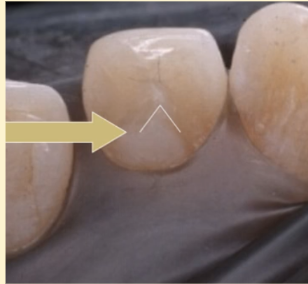
maxillary lateral incisors #7 and #10; lingual tubercle
Looks like a cusp but is the cingulum
maxillary lateral incisors #7 and #10; height of contour; facial
cervical ⅓
maxillary lateral incisors #7 and #10; height of contour lingual;
cingulum
mandibular central incisors #24 and #25; formation begins
3-4 months
mandibular central incisors #24 and #25; eruption
6-7 years
mandibular central incisors #24 and #25; root completion
9 years
mandibular central incisors #24 and #25;
“The twins”
Incisal line angles nearly 90 degrees
Cannot distinguish #24 and #25 on Tooth ID exam
Smallest teeth in the mouth
Incisal edge, proximal contact and root apex align

mandibular central incisors #24 and #25; lingual view
cingulum is central

mandibular central incisors #24 and #25; facial view
bilaterally symmetrical
incisal line angles early 90 degrees
mandibular central incisors #24 and #25; height of contour; facial
cervical ⅓
mandibular central incisors #24 and #25; lingual
cingulum
mandibular lateral incisors #23 and #26; formation begins
3-4 months
mandibular lateral incisors #23 and #26; eruption
7-8 years
mandibular lateral incisors #23 and #26; root completion
10 years

mandibular lateral incisors #23 and #26; cingulum
displaced towards distal
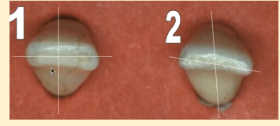
mandibular lateral incisors #23 and #26; incisal edge
usually located lingual to long axis of tooth

mandibular lateral incisors #23 and #26; distal view
incisal edge appears twisted
mandibular lateral incisors #23 and #26; height of contour
facial - cervical 1/3
lingual - cingulum
maxillary canines #6 and #11; begin formation
4-5 months
maxillary canines #6 and #11; eruption
11-12 years
maxillary canines #6 and #11; root completion
13-15 years
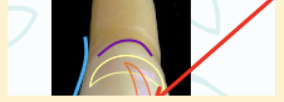
maxillary canines #6 and #11; CEJ
Convex curve toward the apex of the root
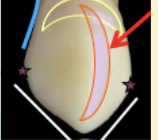
maxillary canines #6 and #11; distal contact
in middle third
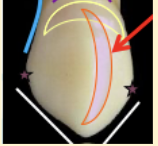
maxillary canines #6 and #11; mesial contact
in junction between incisal and middle thirds but looks more like middle third

maxillary canines #6 and #11; cingulum
height of centered cingulum is half the height of crown
most prominent cingulum

maxillary canines #6 and #11; cusp tips proximal view
cusp tip is facial to center on crown if you split tooth in half from proximal view

maxillary canines #6 and #11; cusp tip buccal view
position of cusp tip is mesial from buccal view

maxillary canines #6 and #11; root depression
mesial and distal depression on root but distal is deeper
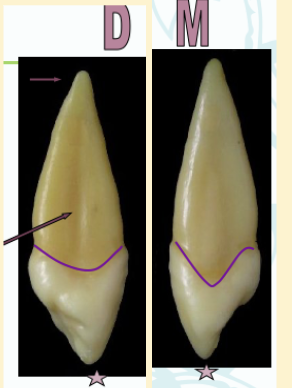
maxillary canines #6 and #11; length
longest root in mouth

maxillary canines #6 and #11; proximal view
wide, short crown from proximal view
wedge/triangular shaped crown
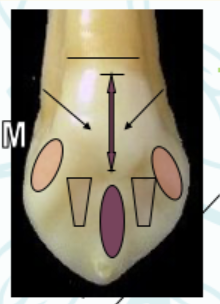
maxillary canines #6 and #11; lingual view
lingual ridge down center
2 lingual fossae-between marginal ridges and lingual ridge
2 marginal ridge
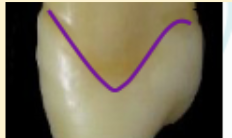
maxillary canines #6 and #11; height of contour; facial
cervical 1/3
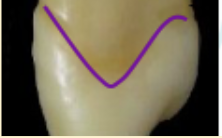
maxillary canines #6 and #11; height of contour; lingual
cervical 1/3 (formed by cingulum)
mandibular canines #22 and #27; formation begins
4-5 months
mandibular canines #22 and #27; eruption
9-10 years
mandibular canines #22 and #27; root completion
12-14 years

mandibular canines #22 and #27; root length
longer crown and shorter root than maxillary canines
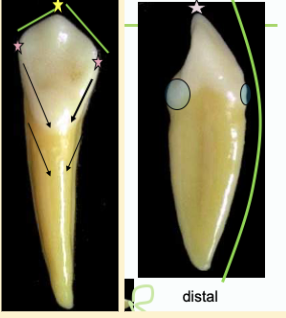
mandibular canines #22 and #27; depression
depressions on both mesial and distal but distal is deeper
depressions are deeper on mand than mexiallry
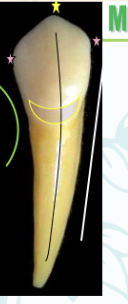
mandibular canines #22 and #27; cusp tip
is mesial to center of crown

mandibular canines #22 and #27; cusp slope
mesial cusp slope is shorter than distal cusp slope
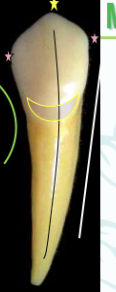
mandibular canines #22 and #27; contact
distal contact more cervical than mesial contact
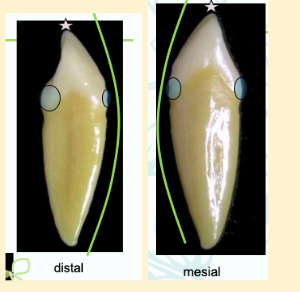
mandibular canines #22 and #27; distal and mesial view
form continuous arc from distal and mesial views

mandibular canines #22 and #27; proximal view
wide, short root from proximal view

mandibular canines #22 and #27; cingulum
cingulum less prominent
cingulum centered or slightly towards distal
mandibular canines #22 and #27; height of contour
Facial= cervical ⅓ Lingual= cervical ⅓ (cingulum)
mandibular canines #22 and #27; max vs mand
max; right
mand; left
